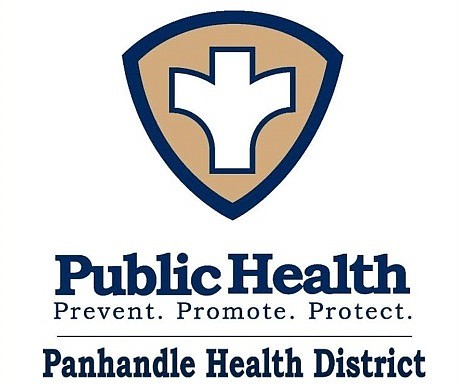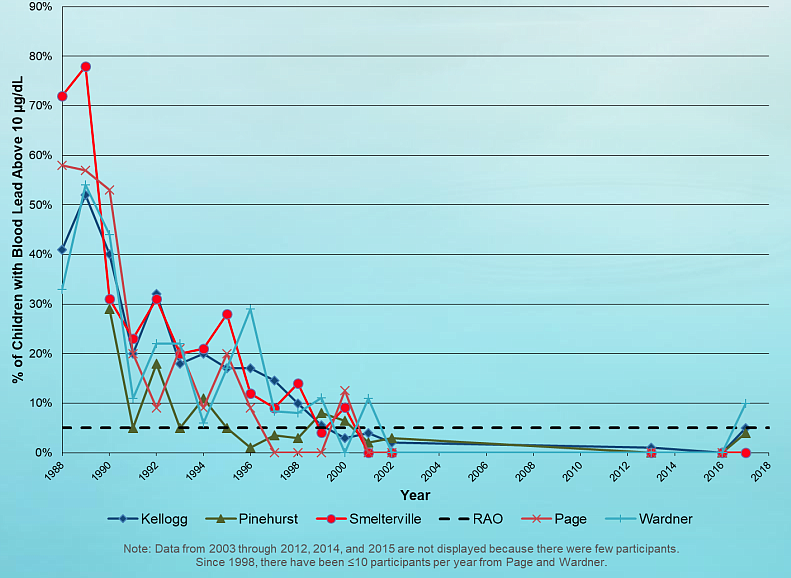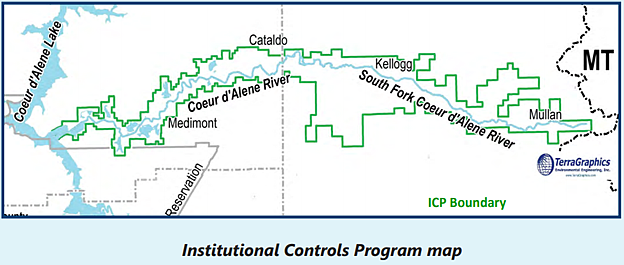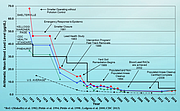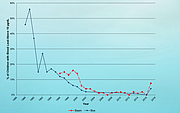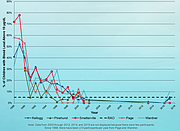PHD set to offer annual lead level testing for children
KELLOGG — The Silver Valley has come a long way in terms of pollution and subjecting its residents to it. One method to track this progress is with the results of Panhandle Health District’s yearly child lead level testing.
This year’s round of free screenings will be offered at Shoshone Medical Center in Kellogg Aug. 13-17 from 9 a.m. to 6 p.m. and Aug. 18 from 9 a.m. to noon for residents living within the Bunker Hill Superfund site. Children ages 6 months to 6 years, living within the Bunker Hill Superfund boundary or Institutional Controls Program area (see ICP map), get tested for free and also receive a $30 incentive.
Testing typically takes 15-20 minutes per person and results are available immediately. Should a child test positive, PHD will also offer to schedule a home visit to identify any available lead source(s) and suggest ways to reduce or eliminate them.
According to PHD, blood-lead monitoring in the Silver Valley began in the early 1970s. At that time, 99 percent of the children tested had blood lead levels more than 40 micrograms per deciliter (µg/dL), with a high of 164 µg/dL. Experts recommend that medical interventions are necessary when a child is found with a test result of greater than or equal to 45 µg/dL.
The Bunker Hill Mining and Metallurgical Site was listed as an EPA Superfund site in 1983. The site covers parts of North Idaho and eastern Washington. It is made up of: the original 21-square-mile “Box” (centered around Kellogg and the Bunker Hill Mine) and other mining-contaminated areas in the “Coeur d’Alene Basin.”
Today, PHD looks to identify levels above 5 µg/dL so families, doctors, and communities can act earlier to reduce and eliminate further lead exposure.
The emphasis on screening children is due in part to their behavior and physiology being more affected by lead.
Children suffer effects from lead exposure at much lower levels. These effects can include behavior problems, lower IQ’s, hearing loss, learning disabilities, decreased bone and muscle growth, kidney damage, nervous system damage and blood anemia.
These screenings also provide data to assess the effectiveness of the Coeur d’Alene basin cleanup and Superfund efforts.
The results of the 2017 screenings in both the Box and the Basin show a slight up-tick in the blood lead levels of children and adults.
PHD tested 124 children from ages 0-6 that lived in the Box and determined the average levels were 3.5 µg/dL (the child with the lowest levels came in at 1.4 µg/dL, while the one with the highest came in at 13 µg/dL). According to the graph provided by PHD depicting the percentage of Box children with blood lead levels under 10 µg/dL by city, 1988-2017, Kellogg children showed the highest levels of exposure. Almost all cities within the box showed exposure increases (for both adults and children) compared to 2016.
In regard to 2017 Basin testing, PHD screened 105 children from ages 0-6 and found the average levels were 4.3 µg/dL (the child with the lowest levels came in at 1 µg/dL, while the one with the highest came in at 20 µg/dL).
Both the upper and lower portions of the Basin saw an increase (for both adults and children) compared to 2016.
Andy Helkey, PHD’s Institutional Controls Program and Lead Health Intervention Manager, states that their are several explanations for the across-the-board increases.
“Trying to compare last year’s data to this year’s is kind of hard because we moved the screenings back an entire month,” he said. “That gives you another month of exposure.”
When Helkey first took on his role at PHD, the screenings were conducted in early July; a time when people aren’t outdoors as often and it isn’t as hot out. With the decision to conduct the 2016 tests in August, PHD received an extra month of data that included time where “record high temperatures led to increased recreation along unremediated areas of CDA Basin.” Higher temperatures also contribute to dryer, more dusty, conditions that make it easier for lead to be kicked up during outdoor recreation.
Although the statistics show higher levels, Helkey wants to keep the test date where it is now so that PHD can get a better idea of how people are being affected throughout the entire summer.
Since 1996, PHD has screened children in the Coeur d’Alene Basin for elevated blood lead levels since 1996 as a public health service through the Lead Health Intervention Program.
All children participating in this year’s screenings must be accompanied by their parent or legal guardian. If you are unsure if you live within the Bunker Hill Superfund Site or for more information, please call Panhandle Health District in Kellogg at 208-783-0707.
According to the CDC, there is no safe blood lead level for children. By taking precautions, you can reduce or eliminate dangerous lead sources in children’s environments before they are exposed. Ways you can avoid lead exposure this summer include:
- Remove dirt from clothes, toys, pets and equipment BEFORE leaving the area. After spending time along the river, dust, shake or wash off what you can to minimize the dirt you bring home. Place wet and dirty clothes in a plastic bag so they can be washed at home.
- When riding ATV’s, motorcycles and bikes, wear protective gear. A mask or bandana over your face can protect you from contaminated dust.
- Play in grassy areas rather than dirt or mud. Ingestion and inhalation are the most common routes of lead exposure — digging up and playing with contaminated soil can increase risk of lead exposure and absorption.
- Wash hands correctly. Keep hands clean, especially after playing outside and before eating. Use soap and warm water, but not creek or river water. Hand sanitizer removes germs but does not remove lead.
- Get screened!

